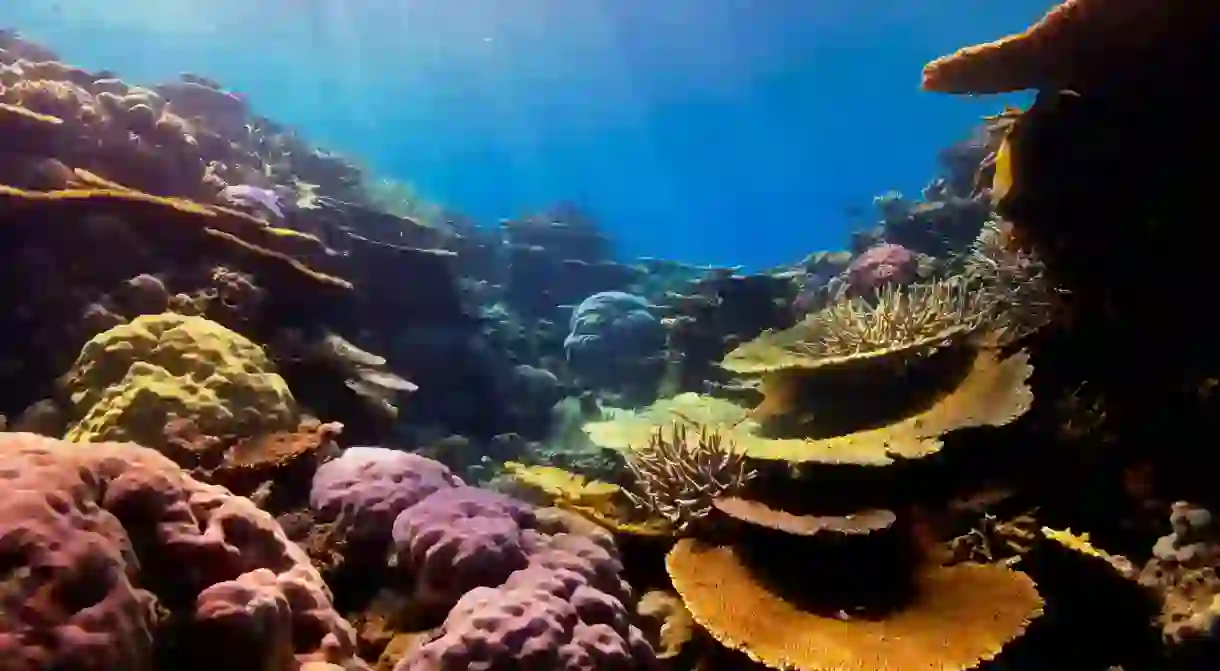The 15 Most Beautiful Coral Reefs in the World

The oceans and seas are incredible things of beauty, with a fascinating mix of underwater gardens and marine life. Of particular importance are the stunning coral reefs, which act as a protection mechanism to coastlines and a home to an array of ecosystems. Many of them are, unfortunately, threatened due to man-made causes and in need of preservation. Here are the most beautiful in the world.
Maldives
Natural Feature

The Maldives are made up of 1,200 islands and 26 atolls; the waters feature a beautiful landscape of corals and vibrant array of marine life. Unfortunately, with the warming of the ocean waters, particularly the El Niño weather event of 1998, a majority of coral suffered from heavy bleaching, dying off; however, over the past few years, there have been encouraging signs of recovery.
Great Barrier Reef – Australia
Natural Feature

Not only is Australia’s Great Barrier Reef one of the most beautiful reefs in the world, but it’s also the largest one on Earth. The reef comprises over 3,000 individual reef systems, complete with abundant colorful marine life and 400 types of coral. Situated off the coast of Queensland, the reef also features hundreds of islands, many of which have pristine beaches that locals and tourists alike flock to every year. One of the Seven Natural Wonders of World, the Great Barrier Reef is also a UNESCO World Heritage Site.
New Caledonia Barrier Reef – New Caledonia
Natural Feature

Red Sea Coral Reef – Red Sea
Natural Feature

Rainbow Reef – Fiji
Natural Feature

Palancar Reef – Cozumel, Mexico
Natural Feature

Belize Barrier Reef – Belize
Natural Feature

Bonaire Reef – Dutch Caribbean
Natural Feature, Park

Tubbataha Reefs Natural Park
A stunning underwater landscape made up of vibrant corals and marine life, Tubbataha Reefs in the Philippines is recognized as a top diving site in the world. Comprising two coral atolls, the reefs feature 600 species of fish, 360 species of coral, 11 species of sharks, 13 species of dolphins and whales, birds, plus Hawksbill and Green sea turtles. The Tubbataha Reef Natural Park was declared a UNESCO World Heritage Site in 1993 due to its ‘pristine coral reef’ along with the ‘extensive lagoons and two coral islands.’
Raja Ampat – Indonesia
The waters of the Raja Ampat Islands have 450 species of reef-building coral, making it an area with the largest coral reef biodiversity based on its size. When scientists discovered this fact, they put a plan into motion to protect this underwater habitat, as so many reefs around the world are at risk. Located in the heart of the Coral Triangle, an area with 75 percent of all identifiable coral species, the area also has an impressive 1,427 species of fish. With the abundance of biodiversity, it should come as no surprise that Raja Ampat is a favored spot among divers.
Great Chagos Archipelago – Indian Ocean
Located in the middle of the Indian Ocean, the Great Chagos Archipelago comprises 55 islands, and the Great Chagos Bank happens to be the largest coral atoll in the world and also the least polluted and the most protected. Half of the world’s coral is located here, with endemic varieties such as the Ctenella chagius, coral that resembles a brain. Add to that the rich fish population, along with turtles, dolphins, whales, and more. In order to keep the water as pristine as possible, scientists conducting research don’t even wear sunscreen.
Wakatobi Islands – Indonesia
A stunner located in the Coral Triangle, the Wakatobi National Park is 1.39 million hectares, and its blue-green water is home to 750 coral reef species out of the world’s 850, making it a spectacular place to explore. A tentative World Heritage Site, this underwater gem is located off the southeast portion of Sulawesi, Indonesia. Adding to the already impressive scene is the diverse fish presence; indeed, the collection of fish equals 942 species.

Lord Howe Island – Australia
Lord Howe Island is a gorgeous island located in the Pacific Ocean. There is much beauty above the sea, but once you dive into the crystal-clear blue waters, there might be even more allure beneath. A marine park and UNESCO World Heritage Site, its marine biodiversity is unique with over 90 coral species along with 500 different species of fish. It’s possible to get close to dolphins, humpback whales, and even sharks (the harmless ones, of course). It is a true paradise.
Apo Reef – Philippines
At 13 miles long, the Apo Reef, located in the South China Sea on the Mindoro Strait, is the second-longest continuous coral reef on the planet. Underneath deep blue waters are a smashing array of corals in blues and pinks along with marine life such as trigger fish and sea turtles. Currently on UNESCO’s tentative list for World Heritage Site status, Apo Reef also has National Park status in order to protect this treasure from any undo harm.
The Grand Central Station and Chimneys – Fiji
The Grand Central Station and Chimneys, located in Fiji, known as the ‘soft coral capital of the world’, is home to an abundance of corals and marine life. The Chimneys feature two coral towers adorned with soft coral in various colors, while the Grand Central Station is known for the for the plethora of sea life the area attracts, including manta rays, marble rays, hammerhead sharks, and many others. The area features 400 corals (that scientists know of) 445 documented marine plants, and over 100 invertebrate species.













